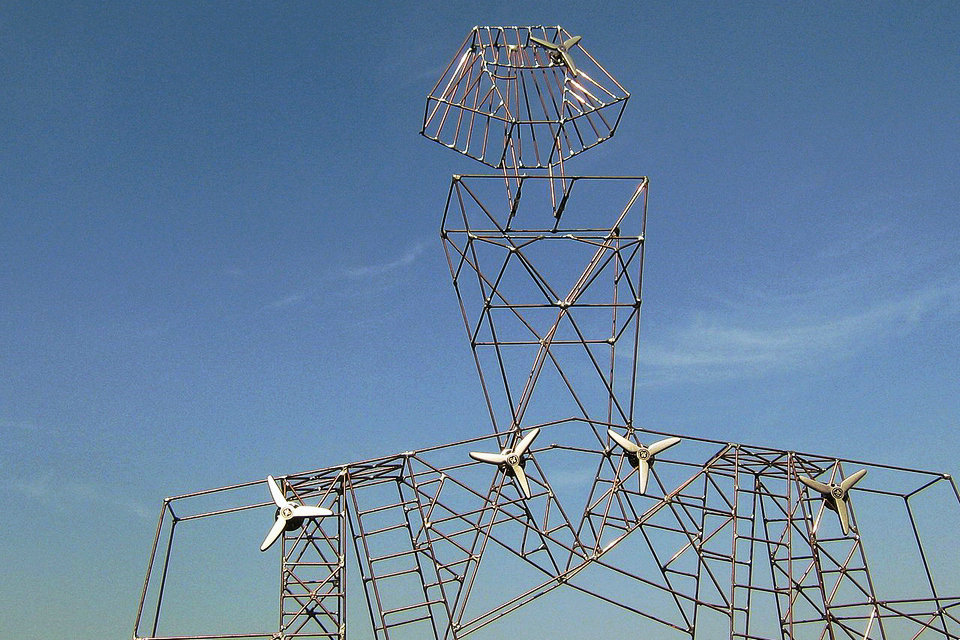Renewable energy sculpture


A renewable energy sculpture is a sculpture that produces power from renewable sources, such as solar, wind, geothermal, hydroelectric or tidal. Renewable energy sculpture is a flow in the environmental art, combining a sculpture, which produce energy from renewable sources (solar, wind, geothermal, hydroelectric or tidal).
Inspired by the folks at Land Art Generator Initiative who are leading the charge, renewable energy art is renewable energy manifests itself in art or as art, most of the examples found are public art pieces.
Features of the current
The main feature of the sculpture of renewable energy is that the artists of this trend are developing solutions that combine the aesthetics with the functional properties of energy production and saving. Practitioners in this growing field often work according to Ecodesign criteria.
Renewable energy sculpture was first proposed by artists such as Patrice Stellest, Sarah Hall, Julian H. Scuff, Patrick Marold, Elena Parucheva, architects Lori Chetwood and Nicholas Grimshaw, Professor of Beckle University of Illinois Bill Becket. Sharing the ideas of environmental art, they believe that the aesthetic part of their work is inextricably linked with the ecological function of the design. In addition, during the sculpture of renewable energy, artists are often inspired by the forms and processes of nature, preferring the colors and textures of the surrounding world.
Such a sculpture is functionally both a renewable energy generator and an artwork, fulfilling utilitarian, aesthetic, and cultural functions. The idea of renewable energy sculptures has been pioneered by ecofuturist visionaries such as artists Patrice Stellest, Sarah Hall, Julian H. Scaff, Patrick Marold, Elena Paroucheva, architects Laurie Chetwood and Nicholas Grimshaw, University of Illinois professor Bil Becket, and collaborations such as the Land Art Generator Initiative. Echoing the philosophy of the environmental art movement as a whole, artists creating renewable energy sculpture believe that the aesthetics of the artworks are inextricably linked to their ecological function.
Quotes
There is something wonderful about knowing that even some small part of the electricity that powers your life is being generated by a work of art that you can visit and enjoy.
Possible translation: There is something surprising in knowing that even a small part of the electricity that nourishes our lives is created by a work of art that you can visit and enjoy.
– Elizabeth Monoian and Robert Ferry
Artists play a key role in transforming people, societies, and cultures simply by reflecting on what is going on around them. Possible translation: Artists play a key role in transforming people, societies, cultures just by thinking about what is happening around.
– Mr. Smith (Project Manager, World saving machine.
Examples of sculptures
The Energy Flow project by Andrea Polli is an example of an experimental architecture that incorporates wind turbines into the structure of the bridge, complementing the design and also illuminating the bridge and surrounding areas.
Ralph Sander’s public sculpture, The World Rescue Vehicle, used solar energy to create snow and ice outside the Seoul Art Museum on a hot Korean summer.
Sarah Hall works with art glass, integrating solar cells that collect solar energy between two glass panels, combining them with the works of art themselves.
The art of Elena Parusheva is designed to draw people’s attention to wind energy. She also seeks to provide an artistic answer to energy consumption issues, helping to disseminate information about the benefits of wind energy. In the gallery below is a photograph of the work of Elena – ” Ondine “, which was created in 2004 using copper and soldering. The sculpture took the form of a woman with jewelry on her neck and wrist, jewelry is a set of wind turbines.
There are several emerging genres of renewable energy art, that range from the photovoltaics or wind turbines powering sculptural lights versus the shape of the energy generating surfaces as sculpture, to using the PV cells or wind turbines for purely decorative effects, last but not least, is representative art depicting various renewable technologies.
Lights on sticks
Lights on a stick seems to be the most common expression of renewable energy as public art as site lighting is required in many different situations…
Whirling lights
Near Munich in 2009, there was a collaboration between Siemens, and artist Michael Pendry [check out the installation sequence!] to illuminate the blades of a 30m diameter wind turbine.
Interactive light (powered by the sun, or wind, or people)
From the dance floor to billboard, these ‘sculptures’ have little pretense in being ‘art’.
BIPV Art
To justify the cost of building integrated photovoltaics, they are often called ‘art’. Somehow most of these examples fall short of the ‘is it art’ smell test and falls into being mere decoration.
Pictorial representation of renewable energy
Paintings to photographs, (but no sculptures yet) depict renewable energy infrastructure as icon – so windmills, solar panels, and cords of biomass fill a genre that seems to be about feeling good while not actually doing good (or being good art). I’m not sure that this genre has any significance to the art world or the sustainability movement, but we’ll see…
PV-Punk
There is also a growing movement to consider the environmental impact of the art world. While renewable energy has yet to power an entire gallery or artist studio – this dialog is bridging between aesthetics/theory and the cultural role of art to explore existential issues – but this is a topic for another time.